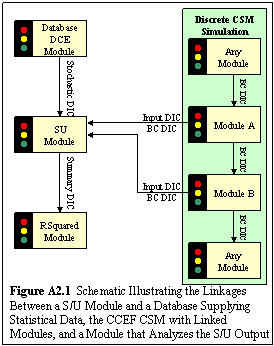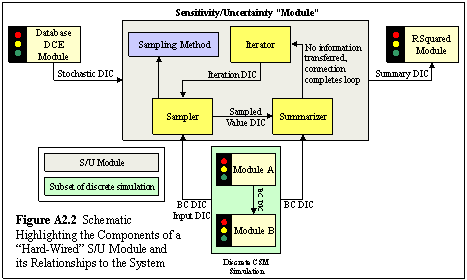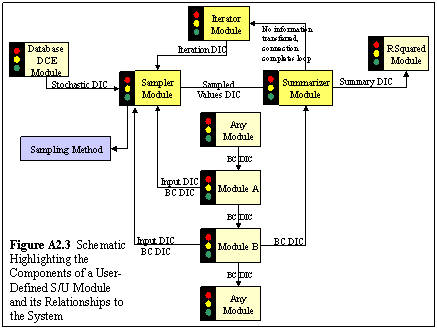
![]() Appendix A
Appendix A
A.1 Data Dictionary
A.2 Sensitivity Uncertainty
A.3 Model Considerations
A.4 Editors
A.5 Server Side
A.2 SENSITIVITY/UNCERTAINTY CONSIDERATIONS
It is envisioned that the system will include a Sensitivity/Uncertainty icon, containing at least one Monte Carlo driver (i.e., model) choice. The Monte Carlo will allow the user to;- Select the models, which will implement the Sensitivity/Uncertainty analysis
- Select the input parameters, which will be varied automatically by the system
- Select the output parameters, which will be monitored for change
- Select the seed number for the random generating program
- Select the distributions associated with the input parameters
- Identify any cross-correlations between parameters
- Define analytical expressions relating one parameter to another parameter
- Populate the Sensitivity/Uncertainty model with statistical information contained in a database. In other words, if a database contains the stochastic information for the independent variables, the user should not have to manually enter this information into the Sensitivity/Uncertainty module.
The Sensitivity/Uncertainty component in the system will be divided into three parts:
- Iterator - defines the number of iterations (e.g., realizations) that are to be implemented. The Iterator passes the current and final iteration numbers to the Sampler and Summarizer, which allows the Sampler to execute the sub-set of modules that are designated by the set of icons connected to the Sampler for the defined number of iterations.
- Sampler - reads the distributions form one simulation or database, samples those distributions, and populates the input files in the copied simulations
- Summarizer - reads input and output files of the modules and generates and output datasets that conform to Sensitivity/Uncertainty Data Dictionary File.
Figures A2.1 through A2.3 illustrate how these three components fit into the overall design of the system.  Figure A2.1 presents a schematic illustrating the linkages between a Sensitivity/Uncertainty Module and a database supplying statistical data, the CCEF conceptual site model, with linked modules, and a module that analyzes the Sensitivity/Uncertainty output. The Database Data Client Editor Module represents a database supplying statistical information on the model input parameters. The R-Squared module represents an illustrative example of a model that statistical analyzes the probabilistic output results (i.e., generating r2 values, which identify the parameters having the greatest influence on variations in the output results). The Discrete conceptual site model Simulation represents the linkage picture of the conceptual site model, developed by the user. The Sensitivity/Uncertainty module and its components are examined in more detail on Figure A2.3 (below).
Figure A2.1 presents a schematic illustrating the linkages between a Sensitivity/Uncertainty Module and a database supplying statistical data, the CCEF conceptual site model, with linked modules, and a module that analyzes the Sensitivity/Uncertainty output. The Database Data Client Editor Module represents a database supplying statistical information on the model input parameters. The R-Squared module represents an illustrative example of a model that statistical analyzes the probabilistic output results (i.e., generating r2 values, which identify the parameters having the greatest influence on variations in the output results). The Discrete conceptual site model Simulation represents the linkage picture of the conceptual site model, developed by the user. The Sensitivity/Uncertainty module and its components are examined in more detail on Figure A2.3 (below).
Figure A2.2 presents a schematic highlighting the components of a  "hard-wired" Sensitivity/Uncertainty module and its relationships to the system. Also highlighted in this figure is the sampling method, as different sampling techniques exist (e.g., straight Monte Carlo, Latin Hypercube Sampling Technique, etc.). In most situations, the Integrator, Sampler, and Summarizer modules will be bundled for the user and will operate as a single module. For those more advanced modelers with an affinity for more sophisticated statistical techniques, there is the ability to separate the Integrator, Sampler, and Summarizer into separate modules, and each can be assigned a specific model. Figure A2.3 presents a schematic highlighting the components of a user-defined Sensitivity/Uncertainty Module and its relationships to the system.
"hard-wired" Sensitivity/Uncertainty module and its relationships to the system. Also highlighted in this figure is the sampling method, as different sampling techniques exist (e.g., straight Monte Carlo, Latin Hypercube Sampling Technique, etc.). In most situations, the Integrator, Sampler, and Summarizer modules will be bundled for the user and will operate as a single module. For those more advanced modelers with an affinity for more sophisticated statistical techniques, there is the ability to separate the Integrator, Sampler, and Summarizer into separate modules, and each can be assigned a specific model. Figure A2.3 presents a schematic highlighting the components of a user-defined Sensitivity/Uncertainty Module and its relationships to the system.
In addition to a Monte Carlo module, other types of modules that function in a similar manner to the Sensitivity/Uncertainty module (i.e., selection and modifying input parameters) would also fit under this category. For example, a number of parameter-estimation programs exist, which would lend themselves for direct inclusion into the system, including UCODE and PEST.

